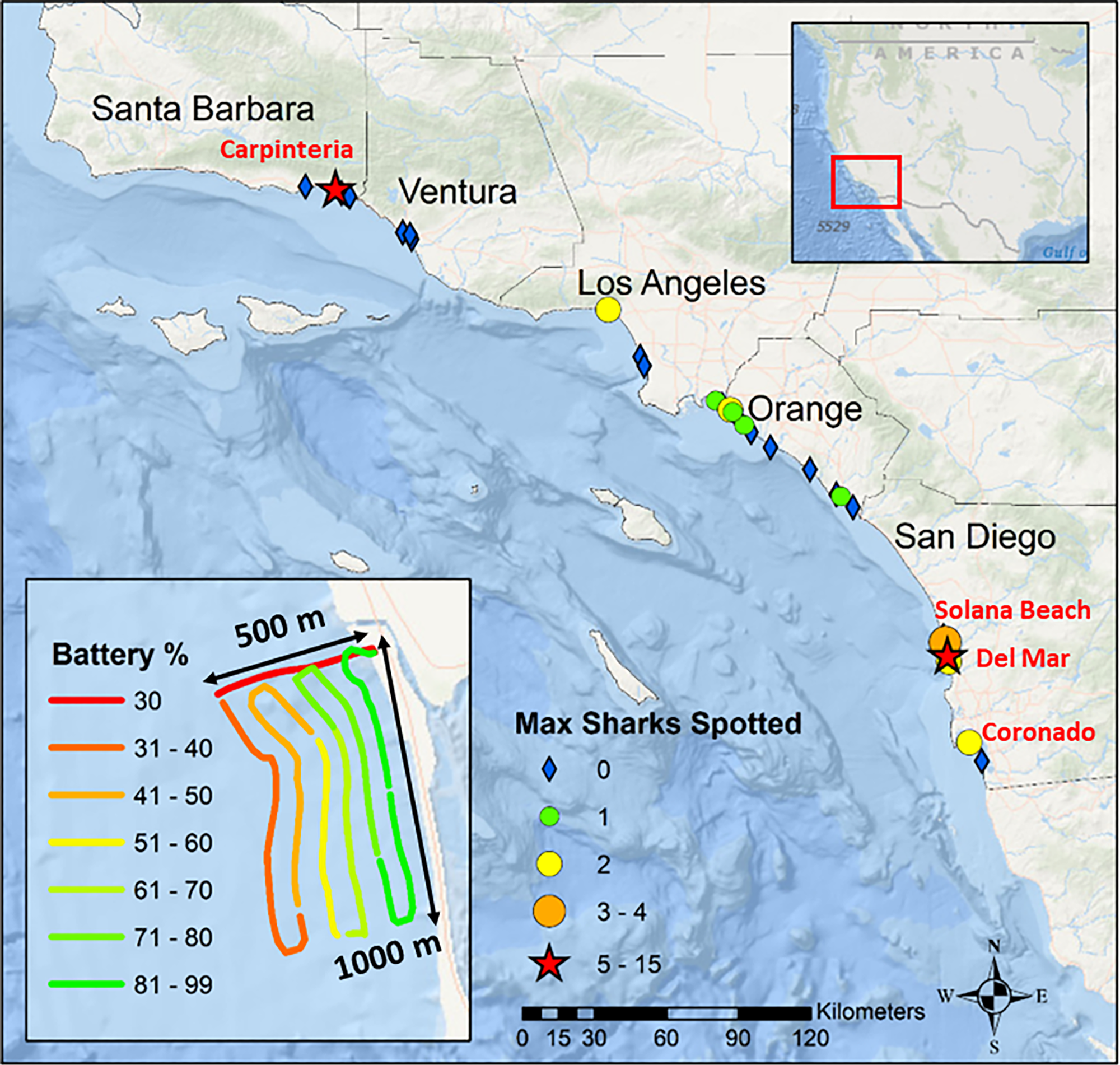A global reduction in the population of large predatory sharks, including tiger, bull, and white sharks, has been noticed since 1970, mostly due to overfishing and loss of key prey. Recent improvement in fishery management and protection has led to the recovery of some of these populations.
An exponential increase in human population, deterioration in climatic conditions, and increasing popularity of human recreational activities in the ocean have potentially increased the risk of shark-human encounters. Regions with high shark-human cooccurrence are believed to have higher rates of shark bites on humans. Although occurring at a very low frequency, shark-human encounters have created a strong negative perception in the general population because of significantly higher news coverage about the dangerous nature of sharks. This has led to a lack of conservation efforts.
In the current study, scientists have determined the rates of shark-human interaction across the entire southern California coastline. They have specifically focused on Juvenile white sharks of the Northeastern Pacific population.
These sharks form large groups (aggregations) and stay for weeks to months at popular beach recreation areas in California. According to recent estimations, the population of white sharks is increasing in the Northeastern Pacific area over the past 20 years. These sharks are also used heavily for human ocean recreational activities, including swimming, surfing, body boarding, and stand-up paddleboarding.
Study design
The survey regions included all five southern California coastal counties and the known aggregation areas for juvenile white sharks. A total of 26 beach locations were included in the survey, and each beach was surveyed once a month using drones. This led to a total of 1644 aerial surveys between January 2019 and March 2021.
Accurate GPS locations of sharks were obtained from drone recording and used to observe sharks’ behavior and potential shark-human interactions. Humans observed during the survey were categorized into five groups: waders, swimmers, bodyboarders, surfers, and stand-up paddlers.
A total of 13 environmental variables were assessed to predict the highest spatio-temporal overlap between juvenile white sharks and humans.
 Map of overall survey area, beaches surveyed, and the maximum number of sharks observed during a single survey. Beaches labeled with red text were aggregation locations where 3 distinct individual sharks were observed on consecutive survey days. Our definition for aggregation site was limited to locations where 5 distinct individual sharks were observed on consecutive survey days and is limited to Carpinteria and Del Mar (stars). Map inset is an example of drone survey path. Base map and map data were produced in ArcGIS. Base map data produced by Esri, Garmin, the General Bathymetric Chart of the Oceans, and the National Oceanographic and Atmospheric Administration National Geophysical Data Center. Map imagery from USGS can be viewed here: https://apps.nationalmap.gov/viewer/.
Map of overall survey area, beaches surveyed, and the maximum number of sharks observed during a single survey. Beaches labeled with red text were aggregation locations where 3 distinct individual sharks were observed on consecutive survey days. Our definition for aggregation site was limited to locations where 5 distinct individual sharks were observed on consecutive survey days and is limited to Carpinteria and Del Mar (stars). Map inset is an example of drone survey path. Base map and map data were produced in ArcGIS. Base map data produced by Esri, Garmin, the General Bathymetric Chart of the Oceans, and the National Oceanographic and Atmospheric Administration National Geophysical Data Center. Map imagery from USGS can be viewed here: https://apps.nationalmap.gov/viewer/.
Important observations
The surveys identified waders and surfers as the most abundant water users, followed by swimmers, bodyboarders, and stand-up paddlers. A total of 1,204 juvenile white sharks were observed during the entire survey period.
Clustered coastal distributions of sharks were observed in the surveys, which limited shark-human interactions to specific locations, including Carpinteria and Del Mar Beach. Nearshore distribution indicated that sharks frequently come closer to the wave break to interact with some water users.
Waders and bodyboarders were less frequently observed outside the wave break and had the lowest nearshore distribution overlap with sharks. A significant interaction between surfers and swimmers was observed with sharks closest to the wave break. Stand-up paddlers generally farthest outside the wave break shared the highest nearshore overlap with sharks.
The daily shark-human interaction was 97% on beaches with shark aggregations, and human activity showed high spatial overlap at shark aggregation sites. A higher seasonal human-shark spatio-temporal overlap was observed at aggregation sites in southern California.
Regarding environmental variables, sea surface temperature, air temperature, and month showed the highest impact on the abundance of all groups of water users. Considering all water user groups, the highest abundance was observed during the summer with high UV, high sea surface temperature, and moderate wave height.
Sea surface temperature and month showed the highest impact on shark abundance. In addition, wave height and wave period, and high UV light showed significant impact.
Spatio-temporal overlap between sharks and humans
The surveys identified Carpinteria as the largest aggregation site within southern California. At this beach, shark observations reduced during winter and peaked during summer. In contrast, human observations remained low until summer and peaked during summer. Despite differences in overall beach-wide distribution, significant overlaps between the primary area of use for both sharks and humans were observed during the study period.
Del Mar was identified as the second largest aggregation site within southern California. At this beach, shark observations peaked during the fall months. The highest temporal overlaps between sharks and humans were also observed in the fall. High beach-specific spatial overlaps between sharks and humans were also observed in Del Mar.
Study significance
The study reveals that shark-human interactions in southern California beaches occur only at locations where shark aggregations have formed. The study identifies human beach-specific area use as the main driver for spatio-temporal overlap between sharks and humans at specific beaches, including Carpinteria and Del Mar.
Notably, the study finds that despite high encounter rates between sharks and humans, aggressive behaviors or unprovoked shark bites at aggregation sites in southern California are very low.